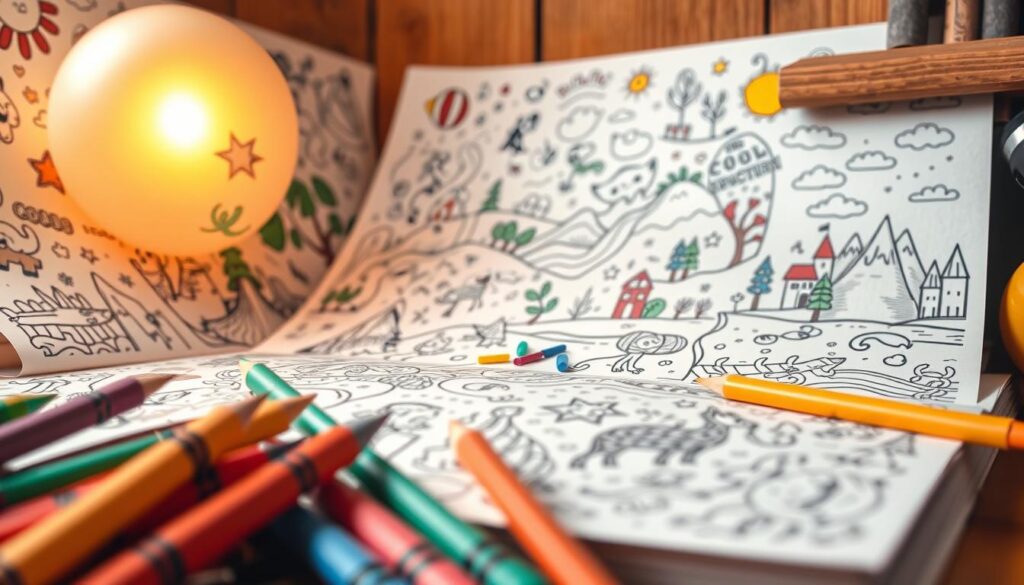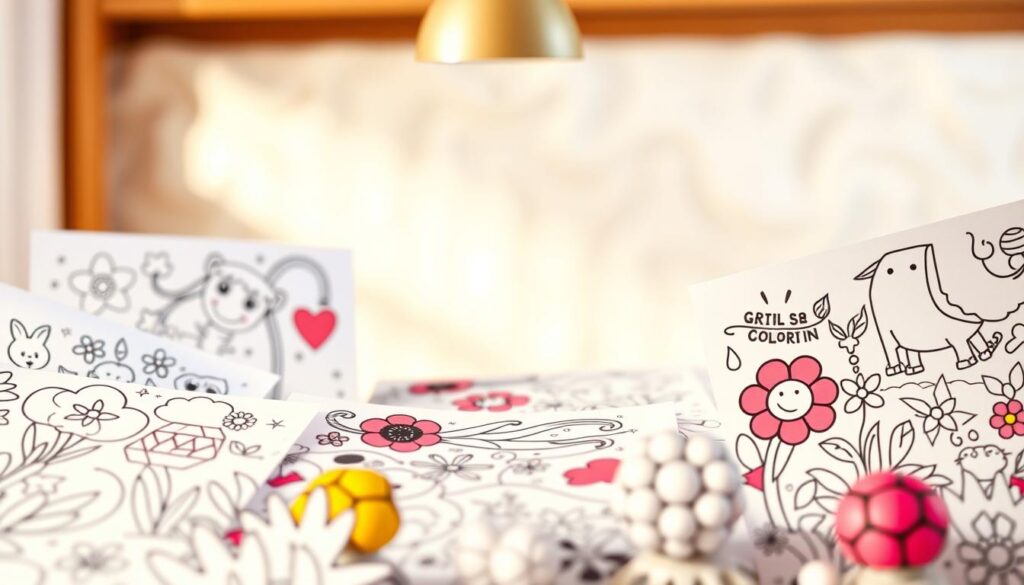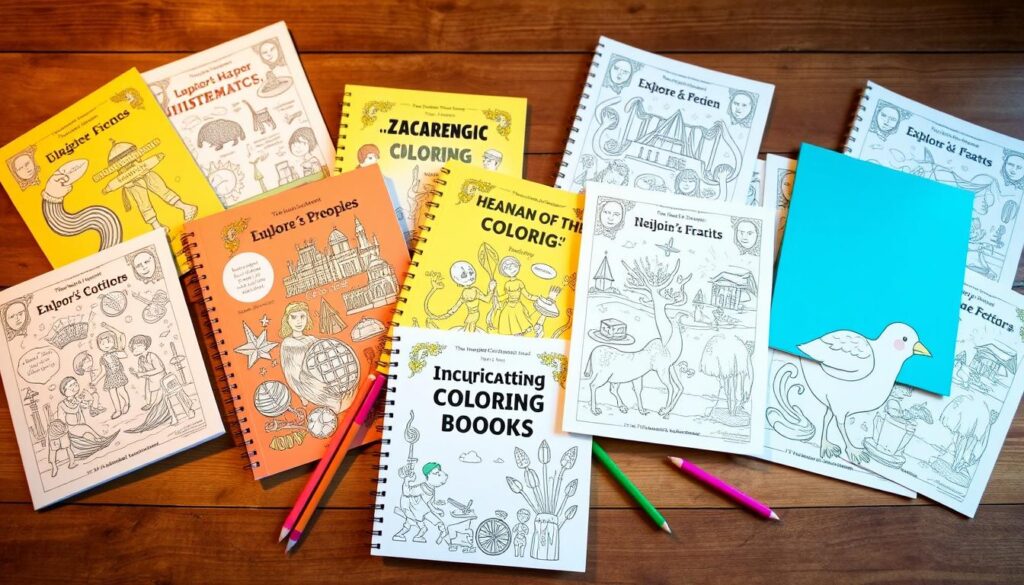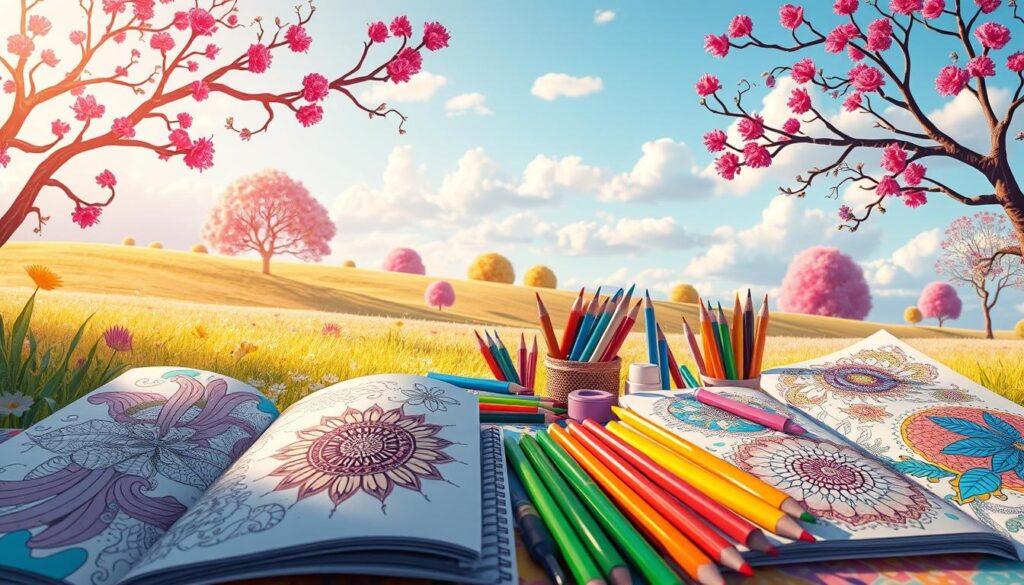Imagine having the ability to create unique and personalized coloring books with just a few clicks. AI art generation has made this possible, revolutionizing the way we create and enjoy art.
With the rise of AI-generated content, creating customized coloring books for kids and adults has become a breeze. This technology offers endless creative possibilities, allowing users to generate complex designs and patterns with ease.
Key Takeaways
- Discover how to create AI-generated coloring books with simple tools and creative prompts.
- Learn about the benefits of using AI art generation for creating customized coloring books.
- Explore the endless creative possibilities offered by AI-generated content.
- Understand how to personalize coloring books for kids and adults using AI technology.
- Get started with creating your own unique coloring books using AI-generated art.
The Rising Popularity of AI-Generated Coloring Books
AI-generated coloring books are becoming increasingly popular, offering a unique blend of technology and creativity. This surge in popularity can be attributed to the unique benefits that AI-generated content brings to the traditional coloring book format.
The digital age has not diminished the appeal of coloring books; instead, it has enhanced their reach and versatility. Coloring books have remained a beloved pastime for both children and adults, providing a creative outlet and a means of relaxation.
Why Coloring Books Remain Popular in the Digital Age
Despite the prevalence of digital entertainment, coloring books continue to thrive. They offer a tactile experience that digital media cannot replicate. The act of coloring is therapeutic, allowing individuals to unwind and express their creativity. Moreover, coloring books provide a digital detox, offering a break from screens.
How AI is Transforming Coloring Book Creation
AI has revolutionized the creation of coloring books by enabling the rapid generation of complex and intricate designs. This technology allows creators to produce a wide variety of themes and patterns, catering to diverse tastes and preferences.
| Benefits of AI in Coloring Books | Description |
|---|---|
| Increased Efficiency | AI generates designs quickly, saving time for creators. |
| Enhanced Creativity | AI algorithms can produce unique and complex patterns. |
| Customization | AI allows for easy modification of designs based on user preferences. |
Understanding the Basics of AI Art Generation
The basics of AI art generation lie in its ability to interpret text prompts. This technology has opened up new avenues for creativity, allowing users to generate unique artwork with simple text inputs.
AI art generation involves complex algorithms that process text prompts to create visual content. This process is made possible through machine learning models trained on vast datasets of images and their corresponding descriptions.
How AI Creates Images from Text Prompts
When a user inputs a text prompt, the AI algorithm analyzes the text to identify key elements such as objects, styles, and themes. It then uses this information to generate an image that corresponds to the prompt.
The quality of the generated image depends on the specificity and clarity of the text prompt. More detailed prompts typically result in more accurate and relevant images.
Types of AI Art Styles Perfect for Coloring Books
AI can generate various art styles that are suitable for coloring books. Two popular styles are line art and pattern-based designs.
Line Art and Outline Styles
Line art is a popular choice for coloring books as it provides clear outlines that users can color. AI can generate intricate line art based on text prompts, making it ideal for creating detailed coloring pages.
Pattern-Based Designs
Pattern-based designs are another style that AI can generate effectively. These designs can range from simple geometric patterns to complex mandalas, offering a wide range of creative possibilities for coloring books.
| Art Style | Description | Suitability for Coloring Books |
|---|---|---|
| Line Art | Clear outlines and detailed drawings | High |
| Pattern-Based Designs | Geometric patterns and intricate designs | High |
By understanding the basics of AI art generation and the types of art styles available, creators can leverage this technology to produce unique and engaging coloring books.
Essential Tools for How to Make AI-Generated Coloring Books
The journey to creating engaging AI-generated coloring books starts with understanding the essential tools at your disposal. To bring your creative vision to life, you’ll need to combine the power of AI art generators with the precision of image editing software.
Free and Paid AI Art Generators
AI art generators are the cornerstone of creating AI-generated coloring books. These tools use complex algorithms to produce unique artwork based on text prompts. Some popular options include:
- DALL-E, Midjourney, and Stable Diffusion: These are leading AI art generators known for their ability to produce high-quality, detailed images. They offer a range of styles and can be fine-tuned to suit your coloring book needs.
- Specialized Coloring Page Generators: There are also AI tools specifically designed for generating coloring pages. These can be a great starting point, especially if you’re new to creating AI-generated content.
DALL-E, Midjourney, and Stable Diffusion
DALL-E, Midjourney, and Stable Diffusion are renowned for their versatility and the quality of their output. They allow users to input text prompts and generate corresponding images. For example, you can create a prompt like “a cat in a garden” and receive a detailed image that can be used as a coloring page.
Specialized Coloring Page Generators
Some AI generators are specifically tailored for creating coloring pages. These tools simplify the process by providing templates and design options that are ideal for coloring books. They can save time and help you produce content quickly.
Image Editing Software for Refinement
While AI art generators can produce impressive images, you’ll often need to refine these images to make them suitable for a coloring book. This is where image editing software comes into play.
- Adobe Photoshop and Illustrator: Industry-standard tools that offer powerful editing capabilities. You can use them to adjust line thickness, remove unwanted elements, and enhance the overall quality of your coloring pages.
- Free Alternatives: GIMP and Inkscape: For those on a budget, GIMP and Inkscape are excellent free alternatives that offer many of the same features as Adobe’s offerings.
Adobe Photoshop and Illustrator
Adobe Photoshop and Illustrator are the gold standard for image editing. They provide a wide range of tools for refining your AI-generated images, from adjusting brightness and contrast to creating intricate line art.
Free Alternatives: GIMP and Inkscape
GIMP and Inkscape are free, open-source alternatives that offer many of the features available in Adobe Photoshop and Illustrator. They’re great options for those who are just starting out or who don’t want to invest in commercial software.
By combining the right AI art generators with capable image editing software, you can create high-quality AI-generated coloring books that will delight your audience.
Setting Up Your AI Coloring Book Project
Creating a successful AI-generated coloring book begins with a well-planned project setup. This involves several key steps that will guide you through the process of creating a high-quality coloring book that resonates with your intended audience.
Defining Your Target Audience
Understanding your target audience is crucial for creating a coloring book that meets their needs and preferences. Are you creating a book for children, adults, or a mixed audience? Knowing your audience will help you tailor the content, complexity, and themes to suit their interests.
- Children: Simple, fun designs with popular characters or themes
- Adults: More complex patterns, relaxing themes, or niche interests
Choosing Themes and Concepts
Selecting the right coloring book themes is vital for capturing your audience’s attention. Popular themes include nature, fantasy creatures, abstract patterns, and seasonal or holiday-themed designs. Consider what’s currently trending or what niche topics might appeal to your target audience.

Planning Your Book's Structure and Page Count
Determining the book structure and page count is essential for a cohesive and engaging coloring book. Decide on the number of pages, the arrangement of content, and whether you’ll include introductory pages or educational elements. A typical coloring book ranges from 20 to 100 pages, depending on its purpose and audience.
- Decide on the total number of pages
- Plan the sequence of themes or difficulty levels
- Consider adding introductory or instructional pages
Crafting Effective Prompts for AI Coloring Pages
Creating engaging AI coloring pages starts with learning how to write effective prompts that guide the AI’s creative process. The quality of the prompt directly influences the output, making it crucial to understand the nuances of prompt engineering.
Prompt Engineering Basics for Coloring Books
Effective prompt engineering for AI coloring pages involves a combination of creativity and technical understanding. To generate high-quality coloring pages, your prompts should be clear, concise, and rich in detail.
Keywords That Generate Clean Line Art
To achieve clean line art, incorporate specific keywords into your prompts. Terms like “line art,” “black and white,” and “illustration” can help guide the AI towards producing the desired output. For example:
- Use “intricate” to encourage detailed designs.
- Incorporate “simple” or “minimalist” for less complex art.
Style Modifiers for Different Effects
Style modifiers can dramatically change the look and feel of your AI-generated coloring pages. Experiment with terms like “whimsical,” “surreal,” or “geometric” to achieve different effects. For instance, adding “vintage” can give your coloring pages a classic, nostalgic feel.
Examples of Successful Prompts for Different Themes
Crafting prompts that resonate with your target audience requires understanding the theme and desired outcome. Here are examples of successful prompts for various themes:
Nature and Animal Prompts
For nature and animal themes, consider prompts that evoke a sense of the natural world. Examples include:
- “A detailed illustration of a forest ecosystem.”
- “A cute cartoon elephant with floral patterns.”
Fantasy and Character Prompts
Fantasy and character themes offer a wide range of creative possibilities. Try prompts like:
- “A mystical dragon surrounded by magical symbols.”
- “A friendly robot with geometric patterns.”
By mastering the art of prompt engineering and experimenting with different keywords and style modifiers, you can create a diverse range of captivating AI coloring pages that appeal to various audiences.
Generating Your First AI Coloring Pages
With AI tools like Midjourney and DALL-E, generating coloring pages has become more accessible than ever. This section will guide you through the process of creating your first AI-generated coloring pages and troubleshooting common issues that may arise.
Step-by-Step Process with Midjourney and DALL-E
To generate AI coloring pages, start by choosing the AI tool you want to use. Both Midjourney and DALL-E are popular options that offer unique features.
- Begin by crafting a detailed text prompt that describes the image you want to generate.
- Input your prompt into the chosen AI tool.
- Adjust any available settings to suit your needs, such as style or complexity.
- Generate the image and review the output.
Tip: Experiment with different prompts and settings to achieve the desired result.

Troubleshooting Common Generation Issues
While generating AI coloring pages can be straightforward, you may encounter some issues. Here are some common problems and their solutions:
Fixing Overly Complex Images
If the generated image is too complex, try simplifying your prompt or adjusting the complexity settings in your AI tool. For example, if you’re using DALL-E, you might reduce the image’s detail level.
Dealing with Unwanted Elements
To remove unwanted elements from your generated image, you can either refine your prompt to be more specific or use image editing software to manually edit the output. Key: Be precise with your prompts to minimize unwanted elements.
By following these steps and tips, you can successfully generate high-quality AI coloring pages that meet your needs. Whether you’re creating for personal enjoyment or for commercial purposes, understanding how to effectively use AI tools is crucial.
Refining AI-Generated Images for Coloring Books
The process of refining AI-generated images can elevate your coloring book’s overall quality. Refining these images is crucial to ensure they are suitable for coloring and meet the desired quality standards.
Converting Complex Images to Line Art
Converting complex AI-generated images to line art is a vital step in creating coloring book pages. This process involves simplifying the image while retaining its essential features.
Using Photoshop Filters and Actions
One effective method for converting complex images to line art is by using Photoshop filters and actions. These tools can automatically simplify images and create a line art effect. For instance, you can use the “Find Edges” filter to highlight the edges of an image, followed by adjusting the contrast to achieve the desired line clarity.
Manual Tracing Techniques
For more control over the line art conversion process, manual tracing techniques can be employed. This involves manually drawing over the AI-generated image to create a line art version. While time-consuming, this method allows for precise control over line thickness and detail.
Adjusting Line Thickness and Clarity
Adjusting the line thickness and clarity of your line art is essential for creating a high-quality coloring book. Consistent and clear lines enhance the overall coloring experience.
Creating Consistent Line Weights
To achieve a professional look, it’s crucial to maintain consistent line weights throughout your coloring book. This can be done by adjusting the line thickness in image editing software like Adobe Photoshop. Consistent line weights help in creating a cohesive and visually appealing coloring book.
Ensuring Printable Quality
Ensuring that your refined images are of printable quality is vital. This involves checking the image resolution and ensuring it is high enough for printing. A minimum resolution of 300 DPI is recommended for clear and crisp prints.
| Refining Technique | Description | Software Used |
|---|---|---|
| Line Art Conversion | Simplifying complex images into line art | Adobe Photoshop |
| Line Thickness Adjustment | Adjusting line thickness for consistency | Adobe Photoshop |
| Image Resolution Check | Ensuring images are of high enough resolution for printing | Various Image Editing Software |
By refining AI-generated images using these techniques, you can create high-quality coloring book pages that are both engaging and enjoyable for users.
Creating Age-Appropriate Coloring Pages
Creating coloring pages that cater to different age groups is crucial for engaging the target audience effectively. The design and complexity of the coloring pages should align with the age and skill level of the intended users.

Designing for Children
When designing coloring pages for children, it’s essential to consider the age and developmental stage of the child. Simple patterns and familiar characters are often a hit with younger children.
Appropriate Complexity for Different Age Groups
For younger children (ages 3-5), simple shapes and large areas to color are ideal. As children get older (ages 6-10), they can handle more complex designs and smaller details.
Safety Considerations in Design
Ensuring that the designs are safe and suitable for children is paramount. This includes avoiding complex or disturbing imagery that might not be appropriate for young audiences.
“The best coloring books for children are those that balance fun with educational content, helping to develop their creativity and fine motor skills.”
Designing for Adults
Coloring books for adults have gained popularity as a tool for relaxation and stress relief. The designs for this demographic can be more complex and detailed.
Intricate Mandalas and Patterns
Intricate mandalas and patterns are particularly popular among adults. These designs offer a challenge and can be very therapeutic.
Stress-Relieving Design Elements
Incorporating elements like nature scenes, abstract patterns, and inspirational quotes can enhance the stress-relieving benefits of coloring books for adults.
By understanding the needs and preferences of different age groups, creators can design coloring pages that are both enjoyable and beneficial.
Legal Considerations for AI-Generated Coloring Books
As you venture into creating AI-generated coloring books, it’s crucial to understand the legal landscape surrounding this innovative art form. The intersection of artificial intelligence and creative content raises unique legal questions, particularly regarding copyright and commercial use.
Understanding AI Art Copyright Issues
The copyright status of AI-generated art is a complex and evolving area of law. Currently, the U.S. Copyright Office has stated that it will not grant copyrights for works created solely by machines without human authorship. This means that AI-generated images for your coloring book may not be eligible for copyright protection in the traditional sense.
Key Considerations:
- Authorship: Who is considered the author of AI-generated art?
- Originality: Does AI-generated content meet the threshold for originality required by copyright law?
- Human Input: How does the level of human input in AI art generation affect copyright eligibility?
Licensing and Terms of Service for Commercial Use
When using AI art generators for commercial purposes, such as creating coloring books for sale, it’s essential to understand the licensing terms and conditions of the AI tool you’re using. Different platforms have varying policies regarding commercial use.
| AI Platform | Commercial Use Allowed | Copyright Claim |
|---|---|---|
| Midjourney | Yes, with restrictions | No explicit copyright claim |
| DALL-E | Yes, with paid plans | Copyright status unclear |
| Deep Dream Generator | Limited commercial use | No copyright claim |
Before using any AI-generated art for commercial purposes, carefully review the terms of service and consider consulting with a legal professional to ensure compliance with current laws and regulations.
Adding Text and Educational Elements
Enhancing your AI-generated coloring books with text can significantly boost their value, whether you’re creating educational content for children or inspirational quotes for adults. By incorporating text, you can cater to different audiences and purposes, making your coloring books more versatile and appealing.

When it comes to children’s coloring books, adding educational elements can make the activity both fun and informative. This can include simple definitions, fun facts, or even basic math and language exercises.
Incorporating Learning Opportunities in Children's Books
For children’s coloring books, you can integrate various educational content such as:
- Vocabulary building: Include new words related to the theme.
- Basic arithmetic: Simple addition or subtraction problems.
- Scientific facts: Interesting facts about animals, plants, or the universe.
This not only makes the coloring book more engaging but also aids in the child’s learning and development.
Adding Inspirational Quotes for Adult Coloring Books
For adult coloring books, incorporating inspirational quotes can enhance the relaxing and meditative experience. Choose quotes that resonate with your audience, whether they’re motivational, calming, or thought-provoking.
“The present moment is the only moment available to us, and it is the door to all moments.” – Thich Nhat Hanh
Such quotes can add an extra layer of depth to the coloring experience, making it more enjoyable and fulfilling.
Organizing and Formatting Your Coloring Book
Once you’ve generated your AI coloring pages, the next crucial step is organizing and formatting them into a cohesive book. This process involves several key steps that will ensure your coloring book is both visually appealing and professionally presented.
Page Layout and Arrangement
When it comes to the coloring book layout, consider the flow and variety of your pages. Arrange your coloring pages in a logical order that makes sense for your theme. For example, you might start with simpler designs and gradually increase complexity, or group similar themes together.
It’s also essential to balance the content. Ensure that you have a good mix of different types of illustrations and that the difficulty level is appropriate for your target audience. Consider creating a storyboard or mockup before finalizing the order of your pages.
Creating Covers and Table of Contents
A well-designed cover is crucial for capturing the attention of potential buyers. Your cover should reflect the theme and style of your coloring book. You can use AI to generate a cover image or design it yourself using graphic design software.
A table of contents is not always necessary but can be useful, especially for themed books or those with complex illustrations. If you decide to include one, keep it simple and ensure it’s easy to read.
Preparing Print-Ready Files
To ensure your coloring book prints correctly, you need to prepare print-ready files. This involves formatting your book into a PDF that meets printing requirements.
PDF Settings for Print Quality
When saving your PDF, ensure you select the highest quality settings. This typically means choosing a resolution of at least 300 DPI and using the PDF/X-1a or PDF/X-4 standard, which are designed for print production.
Bleed and Margin Requirements
Most printers require a bleed area around your design to ensure that the color goes all the way to the edge of the page after trimming. Typically, this is 0.125 inches. Also, maintain a safe margin for the content to avoid important elements being too close to the edge.
| Setting | Recommended Value |
|---|---|
| Resolution | 300 DPI |
| Bleed | 0.125 inches |
| PDF Standard | PDF/X-1a or PDF/X-4 |
By following these guidelines, you’ll be able to create a professionally formatted coloring book that’s ready for print. Whether you’re planning to self-publish or use a print-on-demand service, your print-ready files will ensure the best possible quality for your readers.
Printing Options for Your AI Coloring Books
With your AI coloring book designs ready, it’s time to explore the various printing choices available. You have two primary options: print-on-demand services and local printing solutions. Each has its advantages and considerations.
Print-on-Demand Services
Print-on-demand services allow you to print and distribute your coloring books as orders are received, eliminating the need for a large upfront print run. This method is particularly useful for new creators or those testing the market.
Amazon KDP and Lulu
Popular platforms like Amazon KDP and Lulu offer easy-to-use interfaces for uploading your book files and setting your book price. They handle the printing and shipping, making it a hassle-free experience.
Pricing and Profit Margins
When using print-on-demand services, you’ll need to consider the pricing of your coloring books and the profit margins. For instance, Amazon KDP allows you to set your book price, and you’ll earn royalties on each sale. You can adjust your pricing based on the page count, book size, and other factors to maximize your earnings.
Local Printing Solutions
For those who prefer a more traditional approach or need a large quantity of books, local printing solutions can be a viable option. This involves finding a local printer who can produce your coloring books according to your specifications.
Finding Cost-Effective Printers
To find a cost-effective printer, you can search online for local printing companies that specialize in book printing. It’s essential to compare prices and services, including factors like print quality, paper types, and binding options.
Paper Types and Binding Options
Local printers often offer a variety of paper types and binding options. You can choose from different paper weights and finishes, as well as binding styles such as perfect binding, spiral binding, or hardcover. Selecting the right combination can enhance the overall quality and appeal of your coloring book.
Marketing and Selling Your AI-Generated Coloring Books
As the demand for unique coloring books grows, so does the need for effective marketing strategies to stand out in a crowded market. With the rise of AI-generated content, creators now have the opportunity to produce high-quality, engaging coloring books that appeal to a wide audience.
Online Marketplaces for Physical and Digital Books
Utilizing online marketplaces is a crucial step in selling your AI-generated coloring books. Platforms like Etsy, Amazon, and Gumroad offer vast customer bases and streamlined distribution processes.
Etsy, Amazon, and Gumroad
Etsy is ideal for handmade or unique digital items, while Amazon offers a massive market for physical books. Gumroad, on the other hand, is perfect for selling digital products directly to customers. Each platform has its fees and terms, so it’s essential to choose the ones that best fit your business model.
Setting the Right Price Points
Pricing your coloring books correctly is vital. Research similar products, consider production costs, and factor in your time to determine a competitive price. You can also experiment with different pricing strategies, such as discounts for bulk purchases or bundle deals.
Social Media Marketing Strategies
Social media platforms are powerful tools for marketing your coloring books. By creating engaging content, you can attract potential customers and build a loyal following.
Creating Engaging Content with Colored Examples
Share images of your colored pages to showcase the potential of your books. Use platforms like Instagram and Pinterest, where visual content performs well. Encourage your followers to share their colored versions, creating a community around your products.
Building a Following with Time-Lapse Coloring Videos
Time-lapse videos of coloring pages can be very engaging. They not only demonstrate the quality of your books but also provide a relaxing viewing experience. Share these on YouTube, TikTok, or Instagram to attract and retain followers.
Building a Coloring Book Brand
Establishing a brand identity helps differentiate your products in a competitive market. Develop a consistent visual style, tone, and messaging across all your marketing channels. This consistency will help build recognition and loyalty among your customers.
| Platform | Best For | Fees |
|---|---|---|
| Etsy | Unique, handmade, or digital items | Listing fees: $0.20, Transaction fees: 3.5% |
| Amazon | Physical books, competitive pricing | Referral fees: 15%, Variable closing fees |
| Gumroad | Digital products, direct sales | Transaction fees: 8.5% + $0.30 per sale |
Conclusion
Creating AI-generated coloring books has become an exciting venture, blending art and technology. Throughout this guide, we’ve explored the steps to produce high-quality coloring books using AI tools. From understanding AI art generation basics to refining images, you’ve learned how to craft engaging content for various audiences.
With your AI-generated coloring books ready, the next step is selling them online. You can leverage online marketplaces for both physical and digital books, utilizing platforms like Amazon for print-on-demand services. Social media marketing strategies can also help you reach a broader audience, promoting your unique coloring books to enthusiasts worldwide.
By following the strategies outlined in this guide, you’re well on your way to establishing a successful brand in the coloring book market. Focus on creating AI-generated coloring books that resonate with your target audience, and don’t hesitate to explore various sales channels to maximize your reach.
FAQ
What is the best AI art generator for creating coloring books?
Popular options include DALL-E, Midjourney, and Stable Diffusion, which can generate high-quality images suitable for coloring books.
Can I use AI-generated images for commercial purposes?
It depends on the terms of service of the AI art generator used. Some generators, like DALL-E, have specific licensing terms for commercial use, while others may have restrictions.
How do I refine AI-generated images for coloring books?
You can refine AI-generated images using image editing software like Adobe Photoshop or free alternatives like GIMP, adjusting line thickness and clarity for printable quality.
What are the key considerations for creating age-appropriate coloring pages?
For children, simplicity and safety are key, while for adults, complexity and detail can be emphasized, with considerations for stress-relieving design elements.
How do I prepare my AI-generated coloring book for printing?
Ensure your files are in the correct format, such as PDF, with appropriate settings for print quality, bleed, and margin requirements.
What printing options are available for AI-generated coloring books?
Options include print-on-demand services like Amazon KDP and Lulu, as well as local printing solutions, offering various paper types and binding options.
How can I market and sell my AI-generated coloring books online?
Utilize online marketplaces like Etsy, Amazon, and Gumroad, and leverage social media marketing strategies, such as creating engaging content and building a following with time-lapse coloring videos.
Are there any copyright issues with AI-generated art?
Yes, understanding AI art copyright issues is crucial, as the ownership and usage rights can be complex and vary depending on the generator and terms of service used.
Can I add text or educational elements to my AI-generated coloring book?
Yes, you can incorporate learning opportunities in children’s books or add inspirational quotes for adult coloring books, enhancing the value and appeal of your coloring book.



